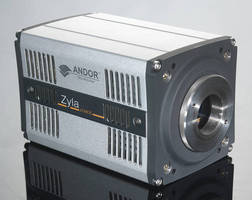CMOS USB 3.0 Cameras offer optimized frame rate performance.
Press Release Summary:

Suited for such microscopy applications as ion signaling, super-resolution, light sheet, and TIRF, USB 3.0 versions of Zyla sCMOS camera offer up to 53 fps performance from 4.2 MP array. Plug-and-play USB 3.0 interface is available on Zyla 5.5 and Zyla 4.2 models, which respectively house 5.5 and 4.2 MP sensors. On-head FPGA real-time data processing promotes maximum image quality and quantitative stability, while dual Rolling and Global Snapshot Shutter capability aids live cell imaging.
Original Press Release:
Andor Launches Zyla sCMOS USB 3.0 Cameras with Market Leading Frame Rate Performance
Belfast, Northern Ireland – Andor Technology Ltd., an Oxford Instruments company and a world leader in scientific imaging and spectroscopy solutions, today announced the launch of USB 3.0 versions of the ultrasensitive, high resolution Zyla sCMOS camera platform. Offering unparalleled frame rate performance of up to 53 fps from a 4.2 megapixel array, coupled with extremely low read noise and wide dynamic range, the Zyla USB 3.0 models are superb price/performance options for a wide range of microscopy applications, such as ion signalling, super-resolution, light sheet and TIRF.
The high bandwidth ‘plug and play’ USB 3.0 interface is available on Zyla 5.5 and Zyla 4.2 models, housing 5.5 and 4.2 megapixel sensors respectively. Zyla offers a light, compact, low vibration design intended for both research and OEM usage. Comprehensive on-head FPGA real-time data processing ensures superior image quality and quantitative stability. The dual Rolling and Global ‘Snapshot’ Shutter capability of Zyla 5.5 renders it an outstanding all round live cell imaging solution. Zyla 4.2 provides the ultimate in sCMOS sensitivity and speed which, coupled with absolute lowest fan vibration, is superbly matched to the needs of the super-resolution microscopy community.
Dr Colin Coates, Andor’s Imaging Product Manager, said; “Andor’s Zyla sCMOS cameras dramatically out-perform interline CCDs across several key parameters and have been widely adopted as a means to significantly upgrade the performance of a fluorescence microscope. Introduction of a speed optimized USB 3.0 interface to our Zyla range boosts performance yet further, but within the price bracket expected of a workhorse ‘plug and play’ camera.”
For more information, please visit www.andor.com/zyla
Enquiries:
For further information please contact Victoria Gault on +44 (0)28 9023 7126, email press@andor.com, or visit http://www.andor.com.
About Andor
Andor is a global leader in the pioneering and manufacturing of high performance scientific imaging cameras, spectroscopy solutions and microscopy systems for research and OEM markets. Andor has been innovating the photonics industry for over 20 years and continues to set the standard for high performance light measuring solutions, enabling its customers to break new ground by performing light measurements previously considered impossible. Andor’s digital cameras, are allowing scientists around the world to measure light down to a single photon and capture events occurring within 1 billionth of a second.
Andor now has over 400 staff across 16 offices worldwide, distributing products to over 10,000 customers in 55 countries. Andor’s products are used in a wide range of applications including medical research to further the understanding of heart disease, cancer and neuronal diseases such as Alzheimer’s and Parkinson’s disease. Andor also has applications for forensic science and astronomy. Through continuous dialogue with customers and strong teamwork, Andor continues to innovate ground-breaking products that improve the world in which we live.
About Oxford Instruments plc
Oxford Instruments designs, supplies and supports high-technology tools and systems with a focus on research and industrial applications. Innovation has been the driving force behind Oxford Instruments' growth and success for over 50 years, and its strategy is to effect the successful commercialisation of these ideas by bringing them to market in a timely and customer-focused fashion.
The first technology business to be spun out from
Oxford University, Oxford Instruments is now a global company with over 2300 staff worldwide and is listed on the FTSE250 index of the London Stock Exchange (OXIG). Its objective is to be the leading provider of new generation tools and systems for the research and industrial sectors with a focus on nanotechnology. Its key market sectors include nano-fabrication and nano-materials. The company’s strategy is to expand the business into the life sciences arena, where nanotechnology and biotechnology intersect.
This involves the combination of core technologies in areas such as low temperature, high magnetic field and ultra high vacuum environments; Nuclear Magnetic Resonance; x-ray, electron, laser and optical based metrology; atomic force microscopy; optical imaging; advanced growth, deposition and etching.
Oxford Instruments aims to pursue responsible development and deeper understanding of our world through science and technology. Its products, expertise, and ideas address global issues such as energy, environment, security and health.




